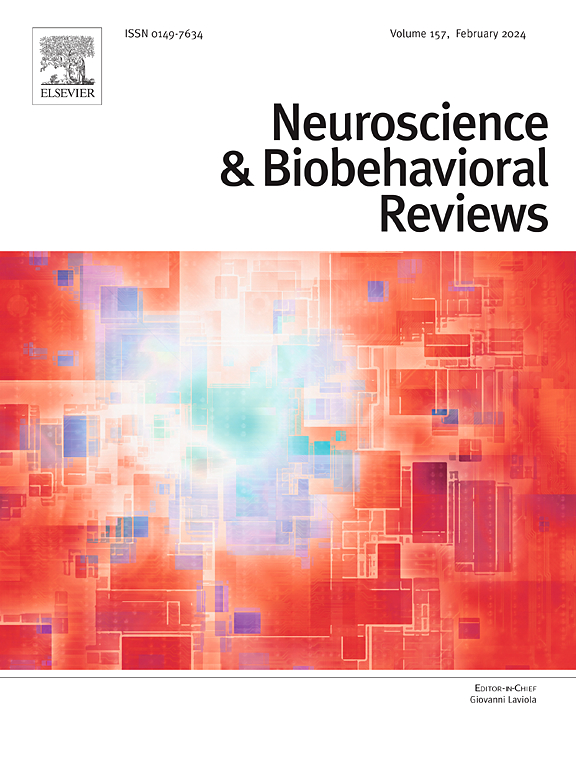不公平会引起愤怒还是厌恶?基于25年神经影像学的定量神经功能解剖。
IF 7.9
1区 医学
Q1 BEHAVIORAL SCIENCES
引用次数: 0
摘要
在过去的几十年里,越来越多的证据强调了情绪对决策的关键影响,传统的“经济人”模型受到了越来越多的挑战。一个典型的例子是最后通牒博弈中的不公平感知,人们愿意牺牲个人利益来惩罚违反公平规范的人。尽管这种代价高昂的惩罚背后的情感机制得到了广泛认可,但道德情感的独特贡献,尤其是愤怒和厌恶,仍然存在争议,部分原因是传统实验方法的局限性。在这里,我们利用定量神经功能解剖方法,整合了神经影像学荟萃分析、行为水平、网络水平和神经化学水平解码的最新进展,利用来自功能神经影像学研究的3266名参与者的数据,确定不公平与两种道德情绪之间的共同和独特的神经表征。我们的研究结果表明,经历不公平涉及一个广泛的双边网络,包括岛状、扣带回和额叶区域,背纹状体区域调节拒绝不公平提议的决定。厌恶涉及一个包含杏仁核、枕叶和额叶区域的防御性回避回路,而愤怒涉及包括中扣带、丘脑和额叶区域在内的非重叠系统。不公平与愤怒和厌恶分别在脑岛前部和中部有共同的激活,而后者还显示腹外侧前额叶和眶额叶皮层的共同募集。多模式网络,行为和血清素解码提供了这些结果的更精细的解剖。总的来说,我们的研究结果表明了一个共同的神经情感基础,通过情绪影响不公平引起的惩罚行为,支持了一个核心脑回路的存在,该回路在进化中形成,以保护个人免受人身伤害并执行社会规范。本文章由计算机程序翻译,如有差异,请以英文原文为准。
Does unfairness evoke anger or disgust? A quantitative neurofunctional dissection based on 25 years of neuroimaging
Over the last decades, the traditional ‘Homo economicus’ model has been increasingly challenged by converging evidence highlighting the critical impact of emotions on decision-making. A classic example is the perception of unfairness in the Ultimatum Game, where humans willingly sacrifice personal gains to punish fairness norm violators. While emotional mechanisms underlying such costly punishment are widely acknowledged, the distinct contributions of moral emotions, particularly anger and disgust, remain debated, partly due to methodological limitations in conventional experiments. Here, we leverage a quantitative neurofunctional dissection approach that integrates recent advances in neuroimaging meta-analyses, behavioral-level, network-level, and neurochemical-level decoding, drawing on data from 3266 participants from functional neuroimaging studies to determine the common and distinct neural representations between unfairness and the two moral emotions. Our results reveal that experiencing unfairness engages a widespread bilateral network encompassing insular, cingulate, and frontal regions, with dorsal striatal regions mediating the decision to reject unfair offers. Disgust engages a defensive-avoidance circuit encompassing amygdalar, occipital, and frontal regions, while anger engages non-overlapping systems including mid-cingulate, thalamic, and frontal regions. Unfairness shares common activation with both anger and disgust, respectively, in the anterior and mid-insula, while the latter additionally shows common recruitment of ventrolateral prefrontal and orbitofrontal cortices. Multimodal network, behavioral, and serotonergic decoding provide a more refined dissection of these results. Collectively, our results suggest a shared neuroaffective foundation through which emotions impact unfairness-induced punishment behavior, supporting the existence of a core brain circuit evolutionarily shaped to protect individuals from personal harm and enforce social norms.
求助全文
通过发布文献求助,成功后即可免费获取论文全文。
去求助
来源期刊
CiteScore
14.20
自引率
3.70%
发文量
466
审稿时长
6 months
期刊介绍:
The official journal of the International Behavioral Neuroscience Society publishes original and significant review articles that explore the intersection between neuroscience and the study of psychological processes and behavior. The journal also welcomes articles that primarily focus on psychological processes and behavior, as long as they have relevance to one or more areas of neuroscience.

 求助内容:
求助内容: 应助结果提醒方式:
应助结果提醒方式:


